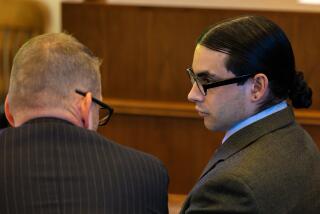Murder Rewards: Merely Symbols?
- Share via
Reward is a five-star eye-grabber of a word, a hook baited in this case with $25,000.00, in red numerals bigger than the headline on this column. If you tell the police who did this, the flier wheedles, we’ll pay you. Invest two dimes in a phone call; it could pay you $25,000.
It’s the American syllogism: Knowledge is power, power is cash, therefore knowledge equals cash.
The point it raises is not what is a life worth? The life in question is long gone. Dyton O’Neil Bailey died briefly from a gunshot wound on Dec. 22, 1994, was brought back to uncertain life by paramedics, and died again, once and for all, at County-USC, on Christmas Eve morning, 1994.
No, the point at issue is, what is an answer worth? What is knowing the truth, telling the truth worth? Official reckoning, public order, public punishment--what are they worth?
*
How, then, out of so much mayhem, does one unsolved coroner’s case find its way onto a police flier with a red-letter reward as rich as a trip to the Big Spin, far better than a year on at minimum wage? What triage determines who are the deserving dead, and who the undeserving dead?
The first of the officially deserving dead I remember was Karen Toshima. She was 27, a Long Beach graphics artist killed by cross-fire outside a movie in Westwood, which in 1988 was virgin territory when it came to gangs.
A $25,000 reward--in essence a worth assigned to finding her killer--aroused such anger that then-City Councilman Zev Yaroslavsky withdrew it, for it had become “so divisive” to his peers, who demanded, was not a South-Central life worth as much as a Westwood life?
So The Reward took hold, and took on symbolism and political power. Each council member can, and does, ask the posting of $25,000 as the imprimatur of official outrage to an unsolved killing. Each vote acknowledges, though, that we prefer our victims utterly blameless, martyrs to urban vice and indifference.
That is evident in the more than 50 victims who received the city’s posthumous sympathy: a retarded man strangled far from home, a 9-year-old run down on the way to the market, a mother of eight shot at her own doorway, and longer-standing mysteries like the pregnant hair stylist stabbed to death at an ATM.
Mark Ridley-Thomas, whose office put forward the Bailey posting, says rewards are most typically “for persons ordinarily deemed to be law-abiding citizens who are often innocent bystanders or victims in the sense of no culpability.”
It is a purely practical matter. A reward is about finding a killer. The more sympathetic a victim--very young or very old, helpless or caught unaware--the likelier that someone will help. Flatly put, murdered gangbangers, crack dealers and gunslingers need not apply.
Dyton Bailey’s parents say right off that he was not perfect; is any 18-year-old boy?
He was on a home study program because he hadn’t finished at Manual Arts or El Camino, and his mother, Beverly Miller, knew he had been doing some graffiti tagging, but not banging. Not when he was home every night and--this is the part that makes her crazy to think about it--they’d sit together and watch the 10 o’clock news with its nightly murder count, and suddenly the day before Christmas, Dyton was South Bureau’s Victim No. 341.
*
Det. Don Richards dangles the printout of unsolved homicides between his thumb and forefinger; it is as thick as a Christmas issue of The New Yorker. “If you want to do columns on just murder suspects, you’ve got job security for life.”
Five FBI agents are on loan to South Bureau to help clean up the backlog, which is one reason that cold cases like Dyton Bailey’s are hot again, why the faces of two men who allegedly murdered honor student Earnest Pickett in front of Dorsey High School 12 years ago are appearing again with a price of $50,000 on their heads.
For weeks now, the police fliers have been handed around through the South-Central neighborhood where Dyton Bailey’s family can no longer bear to live. It could be seen on display in the liquor store-market on South Vermont Avenue (“checks cashed, utilities paid, video rental”) across whose threshold he managed to crawl after he was shot.
Here it is February 1996, and there is still no more for Det. Marcella Winn to go on than whispered street rumors and his mother’s memories of the onetime friend who spit in Dyton’s orange juice almost as a declaration of war and dogged him thereafter.
If every reward the city and county offered last year had been claimed within the 30 days it was offered, those two rather impecunious agencies would have been out more than a million bucks. In any case, only three of the 50 or so were claimed.
In 1985, the Night Stalker was chased down through East L.A. by neighborhood furies who collected their share of that $25,000 reward. A quarter-million people called O.J. Simpson’s $500,000 reward hotline in the first few days. In all these weeks, Marcella Winn’s phone has not rung once about Dyton Bailey.
More to Read
Sign up for Essential California
The most important California stories and recommendations in your inbox every morning.
You may occasionally receive promotional content from the Los Angeles Times.










